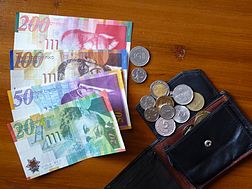New Israeli Sheqel
| Israeli new shekel | |
|---|---|
|
שקל חדש (Hebrew) شيقل جديد (Arabic) |
|

New shekel banknotes and coins (Series B)
|
|
| ISO 4217 | |
| Code | ILS |
| Denominations | |
| Subunit | |
| 1⁄100 | agora |
| Plural | shekels sheqalim |
| agora | agoras agorot |
| Symbol | ₪ |
| Banknotes | ₪20, ₪50, ₪100, ₪200 |
| Coins | 10 agora, ₪½, ₪1, ₪2, ₪5, ₪10 |
| Demographics | |
| User(s) |
|
| Issuance | |
| Central bank | Bank of Israel |
| Website | bankisrael |
| Valuation | |
| Inflation | -0.2% (2016) |
| Source | Bank of Israel, August 2016 |
The Israeli new shekel (Hebrew: שֶׁקֶל חָדָשׁ ![]() Sheqel H̱adash; Arabic: شيقل جديد shēqel jadīd; sign: ₪; code: ILS), also known as simply the Israeli shekel and formerly known as the New Israeli Sheqel (NIS), is the currency of Israel and is also used as a legal tender in the Palestinian territories of the West Bank and the Gaza Strip. The new shekel is divided into 100 agora. The new shekel has been in use since 1 January 1986, when it replaced the hyperinflated old shekel at a ratio of 1000:1.
Sheqel H̱adash; Arabic: شيقل جديد shēqel jadīd; sign: ₪; code: ILS), also known as simply the Israeli shekel and formerly known as the New Israeli Sheqel (NIS), is the currency of Israel and is also used as a legal tender in the Palestinian territories of the West Bank and the Gaza Strip. The new shekel is divided into 100 agora. The new shekel has been in use since 1 January 1986, when it replaced the hyperinflated old shekel at a ratio of 1000:1.
The currency sign for the new shekel ⟨ ₪ ⟩ is a combination of the first Hebrew letters of the words shekel (ש) and ẖadash (ח) (new). Alongside the shekel sign, the following abbreviations of NIS, ש"ח and ش.ج are also used commonly to denominate prices.
...
Wikipedia
